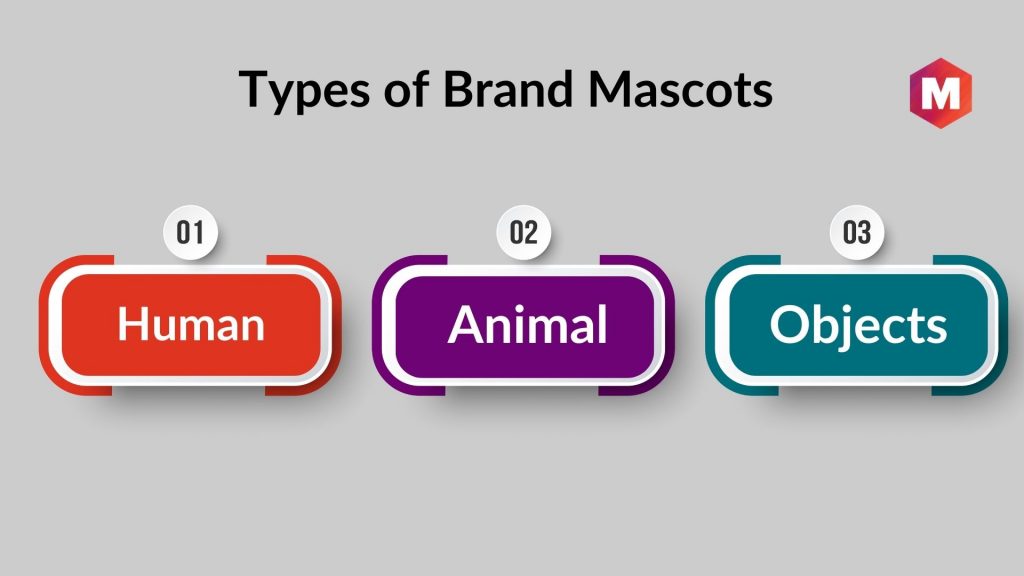Table of Contents
What is a Brand Mascot?
A Brand Mascot is a character that is used to represent a company or product. Brand mascots can be human, animal, or cartoon characters, and are often used in marketing and advertising to build brand awareness and create an emotional connection with consumers.
Brand mascots can be powerful marketing tools, as they can help make a company or product more relatable and likable. And when done well, a Brand Mascot can become synonymous with the company or product it represents.
Think of some of the most iconic Brand Mascots out there:
The Michelin Man, Mr. Clean, Ronald McDonald, The Pillsbury Doughboy, and The Geico Gecko are just a few examples. These characters have helped build strong brands that are easily recognizable and loved by consumers.
Brand mascots can be real, like the Geico Gecko, or fictional, like Ronald McDonald. A mascot’s personality is key in social media posts and brand engagement.
When designing a brand mascot, consider making the character memorable and unique.
Famous mascots are often animals with human-like characteristics. Brand mascots are used in brand marketing to create an emotional connection with consumers. Brand mascots can be used in a variety of marketing campaigns to connect with consumers on an emotional level.
A brand mascot design should be effective and memorable, to help promote a company’s products or services.
Brand mascots can be a human, a cartoon, or a memorable animal character that represents a business.
Importance of Brand Mascot
Key reasons to use Brand Mascots are
1. Builds Brand Awareness
Brand Mascots can help build awareness for a company or product, especially if the character is used in marketing and advertising campaigns.
Brand mascots can also help make a company or product more recognizable and familiar to consumers.
2. Creates an Emotional Connection
Brand Mascots can create an emotional connection with consumers, which can lead to brand loyalty.
When done well, Brand Mascots can become likable characters that people enjoy seeing. This emotional connection can be key to building a successful brand.
3. Makes the Brand More Relatable
Brand Mascots can make a company or product more relatable to consumers.
This is because Brand Mascots help humanize the company or product, making it easier for people to connect with it.
There are many other benefits of using Brand Mascots, but these are some of the key reasons why they can be such a valuable marketing tool.
Brand Mascots can help build strong brands that are recognizable, likable, and relatable to consumers. If you’re looking to create a strong brand identity, consider using a Brand Mascot.
Types of Brand Mascots
1. Human
Brand mascots that are human beings can either be real people or fictional characters. Real people are often used as Brand Mascots if they have a strong connection to the company or product.
For example, Colonel Sanders is the Brand Mascot for KFC. And while he was a real person, his image and persona have become synonymous with the KFC brand.
Fictional characters are often used as Brand Mascots because they can be created to fit the specific image and persona that a company or product is trying to project.
For example, the Geico Gecko is a fictional character that has been created to represent the Geico brand. He is friendly, helpful, and always there when you need him – just like the Geico brand promises to be.
2. Animal
Brand mascots that are animals are often chosen because they fit the image or persona that a company or product is trying to project.
For example, the Michelin Man is a Brand Mascot that is an anthropomorphized Michelin tire. He is strong, reliable, and always there when you need him – just like Michelin tires.
Another example of an animal Brand Mascot is the Aflac Duck. The Aflac Duck was created to represent the Aflac brand, and he does a great job of it.
He’s friendly, helpful, and always there to lend a helping hand – just like Aflac promises to be.
3. Objects
Brand mascots that are objects are often chosen because they fit the image or persona that a company or product is trying to project.
For example, the Pillsbury Doughboy is a Brand Mascot that is an anthropomorphized piece of Pillsbury dough. He is friendly, helpful, and always there when you need him – just like Pillsbury dough.
Another example of an object Brand Mascot is the Mr. Clean Magic Eraser. The Mr. Clean Magic Eraser was created to represent the Mr. Clean brand, and he does a great job of it. He’s strong, reliable, and always there to lend a helping hand – just like Mr. Clean promises to be.
Choosing the right Brand Mascot for your company or product is an important decision. But with so many different types of Brand Mascots to choose from, you’re sure to find the perfect one for your needs.
Mascot Branding Characteristics
1. Color
The color of your Brand Mascot is one of the most important aspects of its design. The color of your Brand Mascot should be chosen to match the colors of your company or product.
For example, if your company’s colors are red and white, then your Brand Mascot should also be red and white.
2. Accessories
Brand Mascots can also be designed with accessories that help them fit the image or persona of your company or product.
For example, the Michelin Man is often seen holding a tire in his hand. This helps to reinforce the fact that he is a Brand Mascot for Michelin tires.
3. Facial Expressions
Brand Mascots should have facial expressions that match the image or persona of your company or product.
For example, the Aflac Duck has a very friendly and helpful expression on his face. This helps to reinforce the fact that Aflac is a company that is always there to help you.
4. Outfits
Brand Mascots should also be designed with outfits that help them fit the image or persona of your company or product.
For example, the Pillsbury Doughboy is often seen wearing a chef’s hat and apron. This helps to reinforce the fact that he is a Brand Mascot for Pillsbury dough.
5. Backgrounds
Brand Mascots should also be designed with backgrounds that help them fit the image or persona of your company or product.
For example, the Mr. Clean Magic Eraser is often seen in front of a clean white background. This helps to reinforce the fact that he is a Brand Mascot for Mr. Clean products.
When it comes to choosing the right Brand Mascot for your company or product, there are many factors to consider. But if you keep these five tips in mind, you’re sure to find the perfect Brand Mascot.
How to create a Brand Mascot?
1. Choosing The Right Character
The first step in creating a Brand Mascot is to choose the right character. This character should be chosen to match the image or persona of your company or product.
- Human Characters: Brand mascots that are human characters are often chosen because they fit the image or persona that a company or product is trying to project.
- Animal (Humanized Animals): Often, animal mascots are chosen as brand characters because they embody the company’s image or persona.
- Object (Humanized Products): Companies choose inanimate objects as their mascots to symbolize and fit the image or persona of their company or product.
2. Deciding Personality of Mascot Characters
The personality of your Brand Mascot is just as important as the physical appearance.
You want your Brand Mascot to be able to connect with your target audience and represent your company or product in the best way possible.
When deciding on the personality of your Brand Mascot, consider the following questions:
- What image or persona do you want your Brand Mascot to project?
- What attributes or characteristics should your Brand Mascot have?
- What kind of emotions do you want your Brand Mascot to evoke in your target audience?
3. Designing Your Brand Mascot’s Physical Appearance
Now that you’ve decided on the personality of your Brand Mascot, it’s time to design its physical appearance.
This is where you’ll decide on things like the color, accessories, facial expressions, outfits, and backgrounds of your Brand Mascot.
When designing the physical appearance of your Brand Mascot, keep the following tips in mind:
- Colors: Your brand mascot should be designed with colors that match your company’s image or persona. For example, the McDonald’s Brand Mascot is designed with the colors red and yellow. This helps to reinforce the image of McDonald’s as a fun and happy place.
- Accessories: Consider giving your brand mascot some accessories that help communicate the image or persona of your brand. For example, the KFC Colonel Sanders Brand Mascot is often seen wearing a chef’s hat and apron. This helps to reinforce the image of KFC as a place for delicious chicken.
- Facial Expressions: Brand Mascots should be designed with facial expressions that match their personality. For example, the Aflac Duck Brand Mascot is often seen with a worried or concerned expression. This helps to create and maintain the image of Aflac as a company that can be relied on in times of need.
- Outfits: Brand Mascots should also be designed with outfits that help communicate the image or persona of your brand. For example, the Geico Gecko Brand Mascot is often seen wearing a business suit. This helps to create the image of Geico as a professional and trustworthy.
- Backgrounds: The background of your Brand Mascot’s design can also help to communicate the image or persona of your brand. For example, the Mr. Clean Brand Mascot is often seen in front of a white background. This helps to create the image of Mr. Clean as a product that can be relied on to clean anything and everything
4. Creating a Brand Mascot Name
Now that you’ve designed your Brand Mascot’s physical appearance and decided on its personality, it’s time to give your Brand Mascot a name.
This name should be reflective of the image or persona that you want your Brand Mascot to project.
Some examples of Brand Mascot names include:
- The Aflac Duck
- The KFC Colonel Sanders
- The Geico Gecko
- The Mr. Clean
5. Planning Visual and Content Marketing Strategy
Now that you’ve created your Brand Mascot, it’s time to start planning your visual and content marketing strategy.
This is where you’ll decide on things like where and how to use your Brand Mascot in your marketing campaigns.
When planning your visual and content marketing strategy, keep the following tips in mind:
- You should think about the story of your character and how you want to communicate that story to your target audience.
- You should also think about the different touchpoints where your Brand Mascot can be used. These touchpoints can include things like social media, your website, email marketing, and even traditional advertising.
- You should also think about how you want to use your Brand Mascot to drive engagement with your target audience. This can be done by incorporating your Brand Mascot into interactive content or using it to run social media contests.
Adding a Brand Mascot to Your Marketing Strategy
There are many upsides to adding a Brand Mascot to your marketing strategy. Brand Mascots can help to
- Create an emotional connection with your target audience
- Make your brand more relatable
- Humanize your brand
- Increase brand awareness and recall
- Drive engagement with your target audience
- Help you to Tell Your Brand’s Story in a Unique Way
If you’re thinking about adding a Brand Mascot to your marketing strategy, keep the tips and ideas in this post in mind.
Doing so will help you to create a Brand Mascot that accurately reflects your brand and resonates with your target audience.
Famous Brand Mascots
Some of the best brand mascots around the world are
1. Mickey Mouse by The Walt Disney Company
The Walt Disney Company is one of the most well-known and beloved brands in the world. And, a big part of that is thanks to their Brand Mascot, Mickey Mouse.
Mickey Mouse was first introduced to the world in 1928 and has since become one of the most iconic Brand Mascots of all time.
2. Ronald McDonald by McDonald’s
Ronald McDonald is the Brand Mascot for the fast-food restaurant chain, McDonald’s.
Ronald McDonald was first introduced in 1963 and has since become one of the most recognized Brand Mascots in the world.
3. The KFC Colonel Sanders by Kentucky Fried Chicken (KFC)
The KFC Colonel Sanders is one of the top brand mascots used for the fast-food restaurant chain, Kentucky Fried Chicken (KFC).
KFC’s Colonel Sanders was first introduced in 1952 and has become one of the world’s most recognizable brand mascots.
For radio ads, Sanders has been voiced by impressionists. From 1998 to 2001, an animated version of him that was voiced by Randy Quaid appeared in television commercials.
4. Michelin Man by Michelin
The Michelin Man is the Brand Mascot for the tire company, Michelin.
The Michelin Man, our brand mascot, was created in 1898. He is made entirely of tires to show that Michelin tires are strong and long-lasting.
5. The Laughing Cow by… The Laughing Cow
The Laughing Cow is a Brand Mascot for The Laughing Cow, a French brand of spreadable cheese products.
The Laughing Cow Brand Mascot was created in 1921 and has become one of the most iconic Brand Mascots in the world. The company’s products are all wrapped in this cheerful cow, making them highly recognizable.
6. Geico Gecko
The Geico Gecko is the Brand Mascot for the insurance company, Geico.
The Geico Gecko was introduced in 2000 and has become one of the most popular Brand Mascots in the world.
He has been featured in a variety of commercials for the company and has helped to make Geico a household name.
7. Rich Uncle Pennybags by Monopoly
Rich Uncle Pennybags is the Brand Mascot for the board game, Monopoly.
Rich Uncle Pennybags was created in 1936 and has become one of the most iconic Brand Mascots in the world.
He is often seen holding a stack of Monopoly money, which is a testament to the game’s wealth-generating ability.
8. Tony the Tiger by Kellog’s Frosted Flakes
Tony the Tiger is the Brand Mascot for Kellogg’s Frosted Flakes.
Tony the Tiger was introduced in 1951 and has become one of the most iconic Brand Mascots in the world.
He is known for his catchphrase, “They’re grrreat!” which is one of the most recognizable slogans in advertising history.
9. Mr. Clean by Procter & Gamble
Mr. Clean is the Brand Mascot for the cleaning product, Mr. Clean.
Mr. Clean was introduced in 1958 and has become one of the most popular Brand Mascots in the world. He is known for his cleanliness and for his ability to get rid of dirt and grime.
10. Coco the Monkey by Coco Pops
Coco the Monkey is the Brand Mascot for the breakfast cereal, Coco Pops.
Coco the Monkey was introduced in 1960 and has become one of the most beloved Brand Mascots in the world.
He is known for his fun-loving personality and for his love of Coco Pops.
Here is a video by Marketing91 on Brand Mascots.
Benefits of Brand Mascots
1. Optimizing brand awareness
Brand mascots can help to optimize brand awareness by increasing the visibility of your brand.
Brand mascots can be used in a variety of marketing communications, such as advertising, public relations, and social media.
2. Differentiating you from competitors
Brand mascots can help to differentiate you from your competitors.
A well-chosen Brand Mascot can help to make your brand more unique and more memorable.
3. Adding value to your brand
Brand mascots can help to add value to your brand by making it more recognizable and memorable.
In addition to staying top-of-mind, brand mascots can help forge an emotional connection with your target market.
4. Making a brand more memorable
Brand mascots can help to make a brand more memorable by increasing its visibility and by establishing an emotional connection with your audience.
5. Making brand communications more effective
Mascots can help make your brand more visible and establish an emotional connection with customers, making marketing communications more effective.
Conclusion
Brand mascots are a key element in many marketing strategies. They can help make a brand’s logo more recognizable and iconic, and create an emotional connection with customers.
When choosing a mascot character, it is important to consider the brand’s values and target audience. The right mascot can help build brand awareness and loyalty, and ultimately drive sales.
What do you think makes a good brand mascot? Let us know in the comments!
Liked this post? Check out the complete series on Branding


